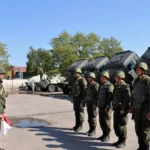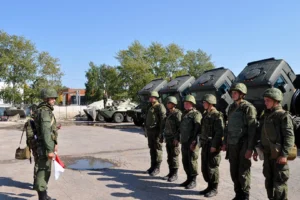Of the three respiratory viruses Americans are grappling with this winter, two — the coronavirus and the flu — are well-known threats. The third, respiratory syncytial virus, which already has sent thousands of children to hospitals, is a mystery to many.
To pediatricians, however, RSV is all too familiar. It is a leading cause of infant mortality around the globe, and especially dangerous to prematurely born babies.
Worldwide, RSV led to about 3.6 million hospital admissions in 2019, and more than 100,000 deaths in children under 5, mostly in poor countries.
“It is, unfortunately, one of those large killers that nobody knows about,” said Dr. Keith Klugman, who directs the pneumonia program at the Bill & Melinda Gates Foundation.
“You survive RSV if you get access to care, to breathing support and to oxygen,” he added. “In the absence of those, babies will die.”
The virus also poses particular risks to pregnant women, immunocompromised children and adults, and adults older than 65. No vaccines and treatments are available. But after decades of stalled progress, more than 30 preventive options are on the horizon, nine of them in advanced trials.
On Tuesday, Pfizer announced that its RSV vaccine showed an efficacy of 82% against hospitalization among infants under 90 days old, and 69% among those younger than 6 months.
The vaccine did not meet the Food and Drug Administration’s threshold for preventing doctor visits, but the company plans to submit its vaccine for approval before the end of the year.
In October, GSK reported that its RSV vaccine had 83% efficacy against serious illness in adults older than 60. The vaccine is under review by regulatory agencies in Europe and Japan, and the FDA is expected to begin its review by the end of the year.
Pandemic restrictions held RSV mostly at bay for the past two years. But this year, children severely ill with RSV are filling up hospitals weeks earlier than usual. More of these young patients are sicker than those seen before the pandemic because they had built up little immunity against RSV.
Babies that survive an RSV infection can sustain damage to the lungs, making them more susceptible to pneumonia. Much of the damage is from the consequences of infection, rather than the infection itself.
Most older children and adults are exposed to RSV multiple times in their lifetimes, and the immunity they gain prevents severe illness, if not infection. Doctors only recently began testing for RSV in adults, leading to the realization that in some years, RSV infections can rival those caused by influenza.
“We just don’t appreciate it as much because the diagnostics are not as available still as they are for either COVID or flu,” said Dr. William Schaffner, an infectious diseases physician at the Vanderbilt University Medical Center in Nashville, Tennessee.
Among older adults, RSV causes about 14,000 deaths per year. Recognition of the scale of the problem is partly responsible for the drive among pharmaceutical companies to develop vaccines.
RSV was identified in the 1950s, and attempts to develop a vaccine began in the 1960s, but researchers were stymied for decades. The field was further set back when a candidate vaccine seemed to increase risk from the virus.
A technical discovery in 2013 at the National Institutes of Health revived the field, allowing scientists to design powerful vaccines. In its trial, GSK’s vaccine had an efficacy of about 94% against severe illness in adults 70-79 years old or those with underlying medical conditions.
“We think we have a vaccine that really can be a very important solution to prevent serious respiratory disease associated with RSV in older adults,” said Dr. Phil Dormitzer, who leads vaccine development at GSK.
Several research teams are working on vaccines for young children. One group, led by Dr. Coleen Cunningham, pediatrician in chief at Children’s Hospital of Orange County and chair of the pediatrics department at the University of California, Irvine, is developing a nasal-drop vaccine containing a weakened version of the virus for children 6-24 months of age.
“The advantage of that is, it’s not a shot, so you don’t have to worry about needles,” Cunningham said. The vaccine would rouse antibodies in the nose, where the virus enters, rather than the blood and so might more effectively prevent infection.
The researchers are trying to find a balance in which the virus is too weak to cause symptoms and yet strong enough to produce a robust immune response. The results so far are promising, Cunningham said.
In the youngest babies, who are most at risk, there is not enough time for vaccines to build sufficient immunity. One alternative is to give babies a monoclonal antibody — a laboratory-made version of a powerful antidote to the virus — that can prevent infection.
One such antibody, Synagis, was approved in 1998 and is injected once a month into infants who were born after 32 weeks of gestation or less, or into those who have heart or lung problems that exacerbate their risks. In trials, the antibody reduced hospitalization from RSV infection by 55%.
But Synagis is rarely used because it is prohibitively expensive, Cunningham said.
Newer monoclonal antibodies may last longer and cost less. A committee of the European Medicines Agency has recommended approval of a single dose of Beyfortus, made by Sanofi and AstraZeneca, to protect children against RSV through an entire season.
Another alternative for protecting infants is to immunize pregnant women. The mother’s antibodies can cross the placenta to the fetus, research has shown, protecting the baby for the first few months after birth.
In the Pfizer trial, about 7,400 pregnant women received a single dose of the experimental RSV vaccine or a placebo during the late second to third trimester. The researchers tracked the women’s health for six months after delivery and the infants for at least one year.
The trial spanned 18 countries and multiple RSV seasons in both the Northern and Southern hemispheres. Klugman of the Gates Foundation said he hoped the vaccine would “roll out very, very quickly” and be available even in poor countries by 2024.
Some companies are testing simultaneous administration of the RSV and flu vaccines and have found so far that neither seems to interfere with the other. Others are working to prolong the duration of protection from an RSV vaccine.
The scale of RSV cases this year underscores the urgent need for vaccines and may serve to convince parents to immunize their children once vaccines are available, the experts said.
“Ironically, perhaps, if these outbreaks have a useful purpose, it will be to make RSV better known,” Klugman said, “so that when the vaccines arrive, there will be enthusiastic opportunity for women to protect their babies.”












